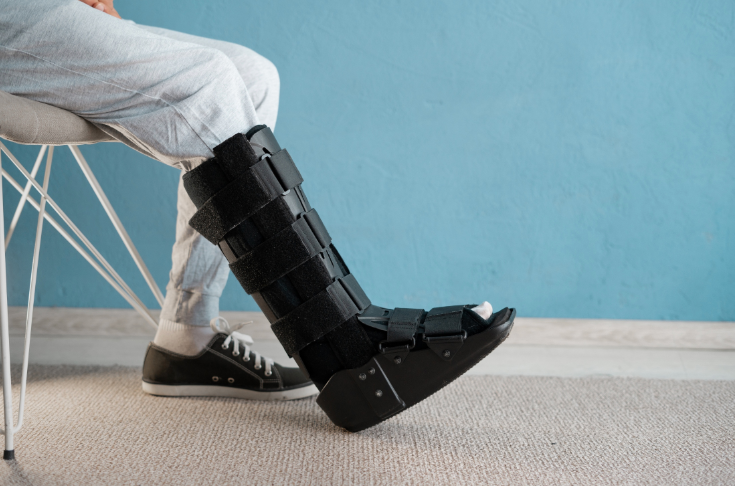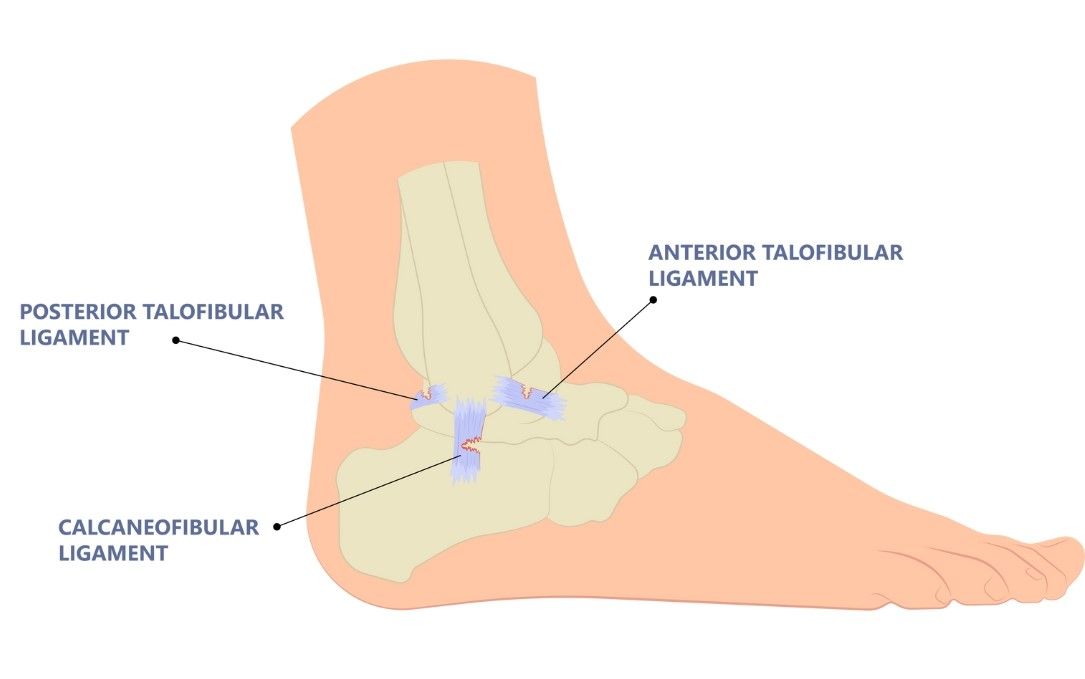Ankle Stabilisation/ Ankle Ligament Reconstruction
What is Ankle Ligament Reconstruction?
Ankle ligament reconstruction is a surgical procedure to repair or reconstruct damaged ligaments in the ankle. These ligaments are bands of tissue that connect bones, providing stability and support to the joint. When ligaments in the ankle are torn or stretched due to trauma, sports injuries, or repetitive stress, the ankle can become unstable, leading to pain, swelling, and difficulty walking.

Indications for Ankle Ligament Reconstruction
Ankle ligament reconstruction is recommended for individuals who experience:
- Chronic Ankle Instability: Repeated episodes of the ankle "giving way" due to ligament laxity.
- Severe Ligament Damage: Tears that have not healed with conservative treatments such as physiotherapy or bracing.
- Persistent Pain or Swelling: Symptoms that interfere with daily activities despite non-surgical interventions.
- High Activity Levels: Athletes or active individuals who need a stable ankle for sports or physical activities.
- Failure of Conservative Management: Cases where physical therapy, rest, or bracing has not resolved the instability.
Benefits of Ankle Ligament Reconstruction
Ankle ligament reconstruction offers several benefits, including:
- Improved Stability: Reduces episodes of the ankle, giving way and allowing better support during movement.
- Pain Relief: Addresses chronic pain caused by ligament damage.
- Enhanced Mobility: Restores normal range of motion and function in the ankle joint.
- Return to Activities: Enables patients to resume sports or physical activities previously limited by instability.
- Prevention of Long-Term Complications: Reduces the risk of further injuries, cartilage damage, or arthritis due to an unstable ankle.
Types of Ankle Ligament Reconstruction
There are two primary approaches to ankle ligament reconstruction:
- Primary Repair:
- Tightens and sutures the existing ligaments back into their proper position.
- Often used for mild to moderate ligament damage.
- Faster recovery compared to more complex procedures.
- Ligament Reconstruction Using a Graft:
- Replaces severely damaged ligaments with a graft, typically harvested from the hamstring or peroneus brevis tendon or a synthetic material
- Commonly performed for severe ligament injuries, in cases of failed primary repair, or in patients with an underlying collagen disorder.
- May involve open surgery or minimally invasive techniques.
Alternative Options to Ankle Ligament Reconstruction
For individuals who may not be suitable for or prefer to avoid surgery, there are several non-surgical alternatives:
- Physiotherapy: Strengthening exercises and balance training to improve stability and function.
- Bracing or Ankle Supports: Use of external devices to support the ankle during physical activities.
- Medications: Anti-inflammatory medications to manage pain and swelling.
- Activity Modification: Reducing high-impact activities that strain the ankle.
Preparation Before an Ankle Ligament Reconstruction
- Consultation with Dr Graff: Discuss your medical history, symptoms, and goals. Undergo imaging tests (e.g., X-rays, MRI) to assess the extent of ligament damage.
- Pre-Surgical Assessments: Complete any required blood tests, ECGs, or health evaluations to confirm your fitness for surgery. Also, inform your surgeon about medications, allergies, and pre-existing conditions.
- Physical Conditioning: If recommended, begin a prehabilitation program to strengthen muscles around the ankle and maintain mobility. This can help speed up recovery post-surgery.
- Lifestyle Adjustments: Stop smoking, as it can impair healing. Avoid medications like aspirin or non-steroidal anti-inflammatory drugs (NSAIDs) that may increase bleeding risk.
- Home Preparation: Arrange your home to make it accessible to those with limited mobility after surgery (e.g., crutches, raised seating). Stock up on essentials like ice packs, wound dressings, and comfortable clothing.
- Plan Support: Arrange for transportation to and from the hospital and ensure someone is available to assist during the initial recovery period.

Ankle Ligament Reconstruction Procedure
Ankle ligament reconstruction is performed under general or regional anesthesia and involves the following steps:
- A small incision is made on the outside of the ankle to access the damaged ligaments.
- The surgeon tightens and sutures the torn ligaments back to their proper position, using synthetic suture material to reinforce this.
- If the ligaments are too damaged, a tendon graft is used to reconstruct the ligament. The graft may be taken from your body (e.g., hamstring) or a synthetic material.
- The reconstructed ligament is anchored to the bone using special sutures or screws.
- The surgeon tests the stability of the ankle to ensure the repair is effective.
- The incision is closed with sutures, and a protective dressing or splint is applied to immobilise the ankle.
The procedure typically takes 1–2 hours, depending on the complexity of the repair.
What to Expect After an Ankle Ligament Reconstruction?
Most surgeries are done as day procedures, but some may require an overnight stay. You’ll receive pain management medications and post-operative instructions.
The Hospital Stay
- You will wake up with bulky bandages and a moon boot.
- Your foot will be elevated overnight, and you will have antibiotics through a drip (you may go home the same day if your surgery is in the morning).
- Elevate your foot on 2-3 pillows if you can safely go home.
- Depending on your other medical conditions, you will need aspirin or clexane injections to thin your blood for 4 weeks.
- You can touch your foot to the ground only for balance for 2 weeks and keep it elevated as much as possible.
At Home
- You will need medications for pain relief; please take two panadol with meals and at night. The first night after you go home post-surgery is often when the worst pain is experienced. Please take a stronger painkiller before you go to bed on the first night after surgery.
- You will need either aspirin or clexane for 4 weeks to prevent blood clots.
- Please leave all dressings intact until your appointment with Dr Graff.
- Dr Graff will see you at your post-op appointment in 2-3 weeks, where the wounds will be looked at and sutures removed.
- After this, you will be able to shower normally, pat the dressings dry, and remove the boot to go to sleep.
Ankle Ligament Reconstruction Rehabilitation
All patients are different. These timelines are only a guide; some patients may progress faster or slower than others.
0-2 Weeks
- Touch weight bearing in a boot
- Keep elevated at other times
- You can put your foot down on the ground for balance if required
- Keep the boot on at all times like a plaster
- Pain relief: Please take regular Panadol with meals and before bed
- Please take aspirin 150mg daily with a meal for 4 weeks until mobile or clexane injections
2-3 Weeks
- At the post-op appointment with Dr Graff, your dressings will be changed
- You can start walking in the boot
- You can remove the boot for showers and sleeping and range of motion exercises with physio
- You can start static strengthening and balance exercises with physio
4-6 Weeks
- You will transition from a boot to a full-time ankle brace
- You can start eccentric strengthening with physio and wobble board
- Cease aspirin/clexane
10-12 Weeks
- You will transition from a full-time ankle brace to an ankle brace for sport-only
- You can ease back into sport. Start with jogging, then running, then training.
- Once your ankle feels as strong as the normal ankle, you can return to sport (also guided by your physio)
When Can I Return To Work/School?
- 3-4 weeks if seated work and you are able to drive (if you drive to work).
- 10-12 weeks if your job requires prolonged standing.
- 3-6 months if your job requires heavy labour.
When Can I Drive?
- 2-3 weeks if the surgery is on your left foot ( after your appointment with Dr Graff).
- 4-6 weeks if the surgery is on your right foot (when you are no longer in the boot).
When Can I Return To Sport?
- It will take three months, but this is a transition. Start with walks, then running, and then training. Your physiotherapist can guide you on when your strength and range of motion will return to normal so that you can return to competitive sport.
Ankle Ligament Reconstruction Prognosis
Most patients experience significant improvements in ankle stability, reduced pain, and an enhanced ability to return to daily activities and sports. Studies indicate that approximately 95% of patients benefit from the results of this surgery.
Ankle Ligament Reconstruction Risks
As with any surgical procedure, ankle ligament reconstruction carries certain risks, including:
- Infection
- Nerve Damage
- Excessive Bleeding
- Stiffness in the Ankle Joint
- Blood Clots (Deep Vein Thrombosis)
- Complications from Anesthesia
- Persistent Instability
Implications of Delaying Ankle Ligament Reconstruction
Postponing necessary ankle ligament reconstruction can lead to several complications:
- Increased Instability: Delaying surgery may further weaken the ankle ligaments, leading to increased instability and a higher risk of recurrent sprains.
- Development of Chronic Conditions: Persistent instability can cause long-term issues such as osteochondral injuries (defects in the cartilage at the tip of the bones) and degenerative arthritis.
- Muscle Weakness and Balance Issues: Ongoing instability can lead to muscle weakness and balance problems, which can affect overall mobility.
Useful Websites
- Lateral Ankle Reconstruction Video: This animation demonstrates the proper techniques for lateral ankle reconstruction of the anterior talofibular ligament (ATFL) and calcaneofibular ligament (CFL). OrthoBullets
- Ankle Ligament Surgery – St Vincent's Private Hospitals: This resource provides comprehensive information on ankle ligament surgery, including types of procedures, recovery expectations, and patient journeys. SVPH
Contact Us
If you need more information or have any questions or problems, please email Dr Graff at admin@christygraff.com or call the rooms at 0493 461 133.
